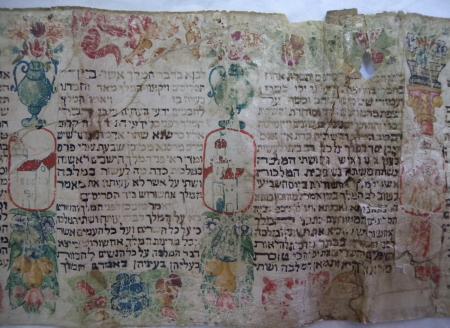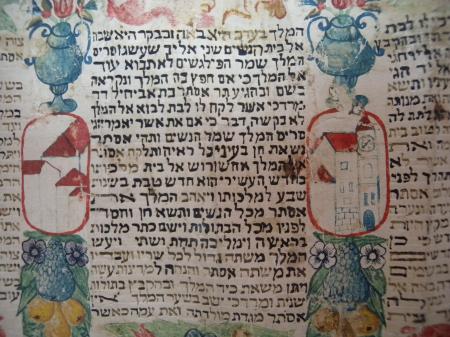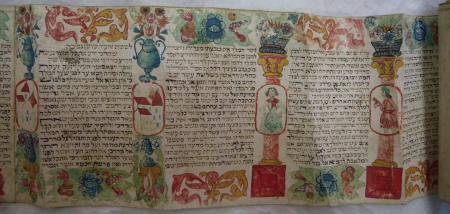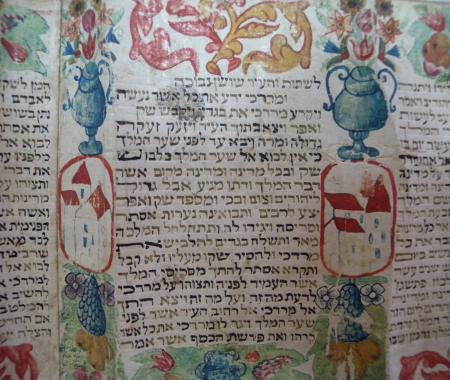Obj. ID: 34771
Hebrew Illuminated Manuscripts Hechal Shlomo Esther Scroll with Houses, Garlands, and Vases, Alsace, 18th century

The manuscript lacks its opening section. The columns of the text are surrounded by hand-painted decorations composed of several motifs. The upper margins are decorated with floral decoration (a kind of garland?) alternately with stylized acanthus leaves that are separated by the flower-filled vases and baskets. The same two types of decorations adorn the lower margins but when the upper margin is decorated with a composition of acanthus leaves, then the lower margin is adorned with a floral motif and alternately. The spaces between the columns - that are not framed - are filled with two types of decorations. The first of them includes columns whose shafts are decorated with ovals containing human figures in fashionable costumes (possibly they are Esther story protagonists but it is impossible to identify the figures). Two ovals flanking col. 24 are exceptionally decorated with the scenes of Haman's sons hanging (Es. 9:14). In addition, on the columns' capitals, baskets with flowers are placed. The other type of decoration is composed of vases with flowers (placed partly in the upper margins), ovals with groups of white buildings with red roofs, and garlands of fruits, flowers, and leaves. In general, the border includes two decorations with houses alternated with two decorations with figures. One more illustration - hanging of Haman (Es. 7:10) - in col. 24 is incorporated.
The scroll is mounted on a wooden rod.
Some decorations are very detailed such as facial features of the figures, wigs, costumes, the letter that is held by a man, but at the same time, many other elements are schematically drawn, e.g. the buildings.
sub-set tree:
O | Ornamentation: | Foliate and floral ornaments | Floral motif
V | Vase | Vase with flowers
A | Acanthus Leaf
G | Garland
H | Human Figure
E | Esther, Book of (following the order of the story) | Esther story protagonists
I | Illustration
B | Buildings
C | Columns
P | Portrait | Portrait medallion
|
The length of the sheets in the scroll: 1) ca. 825 mm, 2) ca. 540 mm, 3) 535 mm, 4) 275 mm.
Dimensions of the selected details in the scroll:
- text column: 75 x ca. 55 mm;
- upper and lower margins: 23 mm;
- spaces between the text panels: 20 mm;
- ovals: 30 mm (height);
- illustration in col. 24: 75 mm (height).
An average letter is 2 mm high whereas the letters in col. 24 are 3 mm high.
The space between the subsequent lines is 2 mm high.
The rod: 260 mm.
The Book of Esther in Hebrew
The scroll is composed of 4 sheets containing 28 text columns with 19 or 20 lines, except for col. 24 with 11 lines.
The text is inscribed in the Hebrew square Sephardi script resembling otiot Amsterdam, in black ink of two shades, on the flesh side of the parchment sheets that are quite thick and stiff. Both sides of the sheets are very similar but the flesh side is more matte than the hair side that is more smooth and shiny.
The letter ת (Es. 9:29) is highlighted by its size. It cannot be determined if the ח (Es. 1:6) is highlighted too.
The name of God is highlighted at least 3 times on the second sheet; the letters forming it are enlarged (they are 3 mm high).
Other enlarged and diminished letters are included in col. 24.
The last column in the scroll is narrowing downwards - the last few lines in it are shorter than the others.
The ruling is made with a stylus.
The membranes in the scroll are glued.
None
Unknown





















